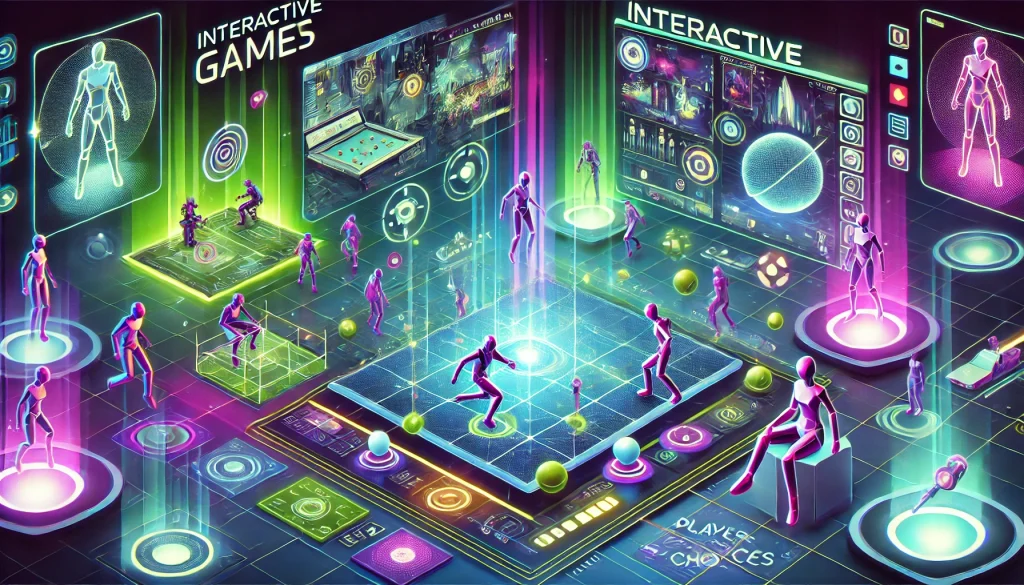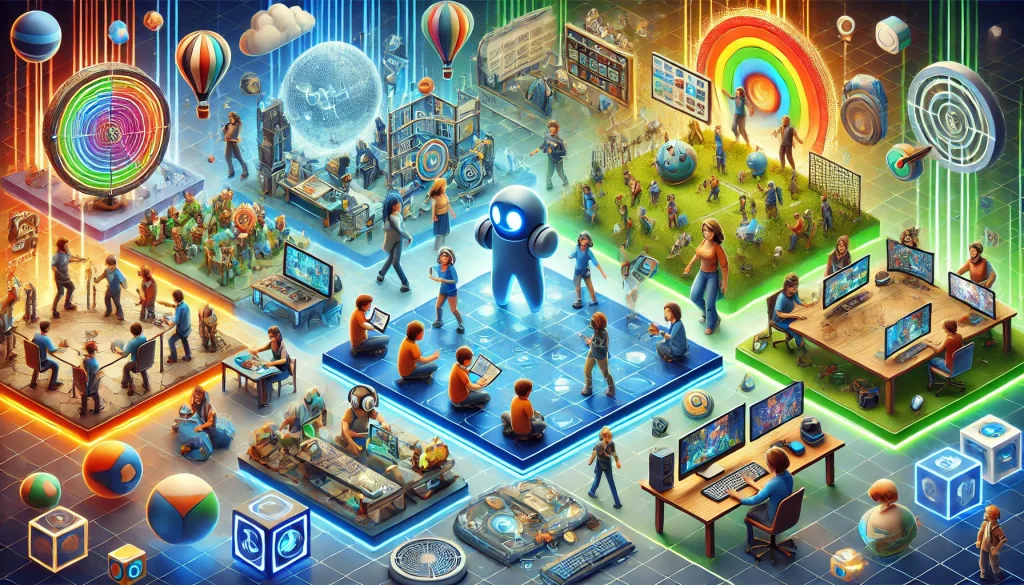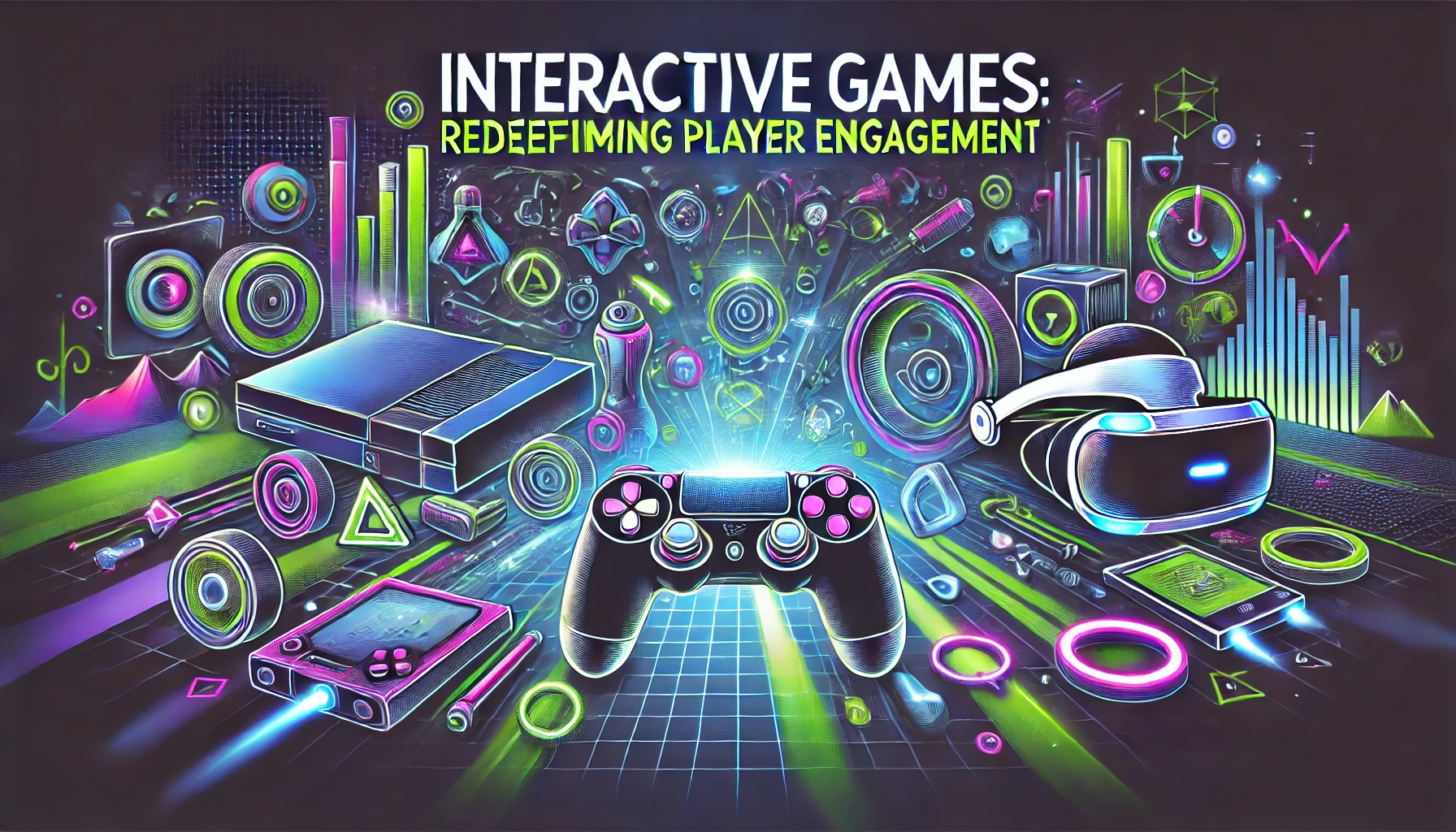The gaming world has always thrived on the dynamic interaction between players and their digital environments. But today, with the emergence of interactive games in the metaverse, player engagement has reached unprecedented heights. Unlike traditional video games, interactive games provide a more immersive and personalized experience, allowing players to shape their worlds, interact with virtual characters in real time, and even influence the outcomes of the game.

In the metaverse, these interactive games are not just about winning or losing—they’re about building connections, fostering creativity, and exploring limitless possibilities. With players now able to interact with both the game and each other in ways previously unimaginable, the boundary between reality and the virtual world has become increasingly blurred.
The Rise of Interactive Games in the Metaverse
The metaverse has quickly become the next frontier for gaming, bringing with it a vast array of interactive games that are more engaging than ever before. These games don’t simply offer a passive experience; they immerse players into worlds where every decision has a ripple effect, creating new outcomes based on player choices. From fully interactive storylines to immersive 3D worlds where you can explore, fight, or even socialize, the metaverse promises an entirely new level of gameplay.
Imagine playing in a gxme spxce where your actions directly influence the game’s direction, or using advanced AI-driven characters who respond uniquely to your every move. Whether it’s battling mythical creatures in vast fantasy worlds or exploring the outer reaches of space, the appeal of interactive games lies in their ability to offer players control over their narratives, environments, and interactions.
A New Frontier for Creativity and Social Connection
Unlike traditional games, interactive metaverse games encourage creativity and collaboration. Players can design their worlds, create unique characters, and embark on adventures with friends across the globe. These virtual spaces—often referred to as gxme spxce—allow for shared experiences that are both meaningful and fun. The metaverse provides opportunities for players to socialize, collaborate, and even form communities based on shared interests within the game.
Moreover, metaverse platforms offer continuous updates and expansions, keeping players engaged and eager to return for new challenges and experiences. Popular examples of these interactive games include the likes of Abcya and Starfall, which have introduced learning elements and allowed young players to explore in ways that traditional gaming platforms never could.
Why Are Interactive Games So Popular in the Metaverse?
One of the key questions we need to answer is: What makes it so popular in the metaverse?

At their core, interactive games offer something that traditional gaming has struggled with—control. Players are no longer restricted by linear storylines or predefined outcomes. In the metaverse, the player’s experience is shaped by their actions, decisions, and creativity. The interactive games in these environments leverage real-time decision-making, allowing players to feel a greater sense of ownership and immersion. The more time players invest, the more the game world adapts and changes based on their actions.
Types of Interactive Games
The variety of interactive games found within the metaverse is staggering. From educational platforms like Abcya, which helps young learners build essential skills through gameplay, to creative sandbox environments like Turtle Diary, where imagination knows no bounds, the metaverse caters to all types of players.

- Sandbox Games: These games, such as Turtle Diary, offer players the chance to build, create, and experiment in an open world without predefined goals.
- Narrative-driven Games: Some metaverse games are more story-centric, where every decision influences the story’s progression.
- Social Games: These games focus on interaction between players and allow for large-scale social events within the game, such as virtual concerts or collaborative challenges.
- Educational Games: Platforms like Starfall and Reading games integrate learning with fun, offering a perfect balance of education and entertainment.
The metaverse expands the concept of “interactive” by enhancing gameplay and deepening player engagement.
What You Need to Know About Interactive Games in the Metaverse
Before exploring interactive games, it’s important to understand their evolution and why they’re vital to entertainment’s future.
The Beginning of Interactive Games

Interactive gaming began with simple decision-making in early video games but truly flourished with the rise of the metaverse. This evolution has turned basic gameplay into immersive experiences, where players have full control over their actions and surroundings. Advances in game engines, virtual reality (VR), and artificial intelligence (AI) have enabled developers to create more intricate and lifelike virtual worlds, revolutionizing the way players engage with games.
Platforms like Abcya and Starfall combine gaming with education, enabling players to learn while playing. Similarly, Reading games make learning a core part of entertainment.
The Benefits
The allure of interactive games goes beyond their entertainment value. They offer numerous benefits, including:
- Enhanced Learning: Educational platforms like Starfall and Abcya make learning fun and engaging through interactive elements that captivate younger audiences.
- Increased Social Interaction: Multiplayer interactive games create virtual spaces for people to connect, collaborate, and compete with others globally.
- Creativity and Problem Solving: These games challenge players to think critically, develop strategies, and make real-time decisions, enhancing cognitive functions.
- Immersive Experiences: Games that incorporate VR or AR allow players to become fully immersed in a digital world, blurring the line between the game and reality.
With benefits like these, it’s no wonder that this are rapidly becoming the new standard in both entertainment and education.
Latest News Features

As the metaverse continues to grow, the world of it is evolving at a rapid pace. Here are five of the most exciting developments in this space:
- Real-time Multiplayer Experiences: Recent updates in Gxme Spxce allow for seamless multiplayer interactions, making it easier for players to collaborate in real-time.
- AI-Powered Characters: Games now feature advanced AI-driven characters that learn from player interactions, creating a more personalized and unpredictable gaming experience.
- Cross-Platform Playability: More and more metaverse games are enabling cross-platform play, allowing players on different devices to interact in the same virtual space.
- Virtual Economies: The introduction of virtual currencies and NFTs (Non-Fungible Tokens) in games allows players to trade, sell, and even earn real-world money within the game.
- Augmented Reality (AR) Integration: The future of it could see a greater emphasis on AR, bringing the game world into our physical reality, enhancing the immersive experience.
These developments signal an exciting time for it and hint at the limitless potential of player engagement in the metaverse.
Conclusion
The world of interactive games is not just changing how we play—it’s redefining how we connect, learn, and create within digital spaces. As the metaverse continues to evolve, the lines between reality and the virtual world will blur even further, offering players new and thrilling ways to engage with both technology and each other. If you haven’t yet, now is the perfect time to explore the fascinating universe of interactive games and experience firsthand the future of gaming.
FAQ
What are interactive games in the metaverse?
Interactive games in the metaverse are immersive digital experiences where players can shape the environment, influence game outcomes, and interact with other players in real-time. These games often incorporate features like virtual reality, AI-driven characters, and cross-platform play.
How can interactive games benefit education?
Platforms like Abcya and Starfall demonstrate how interactive games can be used as educational tools. These games make learning fun and engaging by combining gameplay with lessons on topics like math, reading, and problem-solving, making them ideal for younger audiences.
What are some popular interactive games?
Popular interactive games in the metaverse include platforms like Gxme Spxce, Turtle Diary, and educational titles such as Starfall and Reading games, which combine entertainment with learning in innovative ways.
Resources
- E-Student. ABCya Review
- The Canadian Homeschooler. How Starfall Can Help Your Child Love Learning: A Review
- Dragon Rambles. Reading Games for 2024
- NFT Plazas. Top Metaverse Games 2024
- DKbutdisisatest. Test Website

